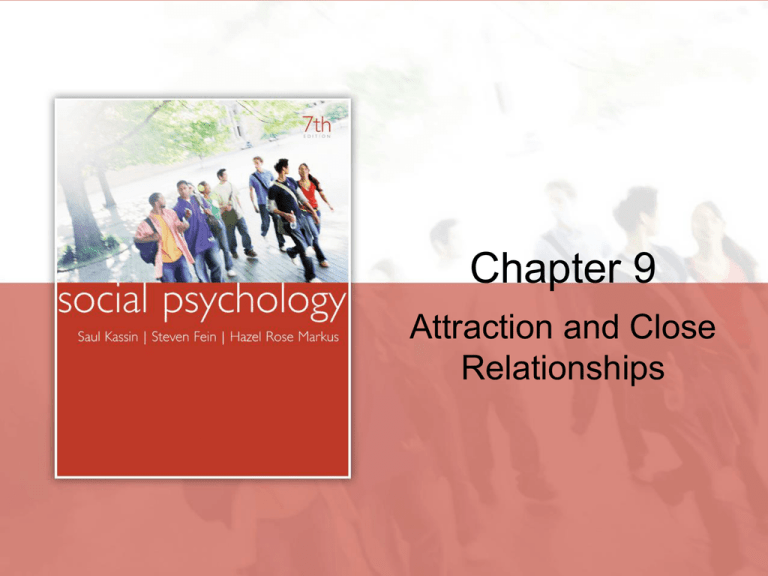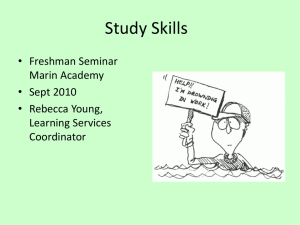
Chapter 9
Attraction and Close
Relationships
Being with Others
A Fundamental Human Motive
Copyright © Houghton Mifflin Company. All rights reserved.
9|2
Putting Common Sense to the Test…
People seek out the company of others, even
strangers, in times of stress.
Answer: True… Let’s see why!
Copyright © Houghton Mifflin Company. All rights reserved.
9|3
The Need to Belong
• The need to belong is a basic human motive.
• We care deeply about what others think
of us.
• Those with a network of close social ties tend to
be happier, healthier, and more satisfied with life
than those who are more isolated.
Copyright © Houghton Mifflin Company. All rights reserved.
9|4
The Thrill of Affiliation
• Need for Affiliation: The desire to establish social
contact with others.
– We are motivated to establish and maintain an
optimum balance of social contact.
• Stress arouses our need for affiliation.
– “Fearful misery loves company.”
– But, “embarrassed misery seeks solitude.”
– “Misery loves the company of those in the same
miserable situation.”
Copyright © Houghton Mifflin Company. All rights reserved.
9|5
Shyness: A Pervasive Problem
60
50
40
Percentage
Describe Self 30
as Shy
20
10
0
United
States
Israel
Copyright © Houghton Mifflin Company. All rights reserved.
Germany
Taiwan
Japan
9|6
Shyness
• Sources
– Inborn personality trait
– Learned reaction to failed interactions with others
• Painful consequences
–
–
–
–
Negative self-evaluations
Expectations of failure in social encounters
Self-blame for social failures
Self-imposed isolation
Copyright © Houghton Mifflin Company. All rights reserved.
9|7
The Agony of Loneliness
• A feeling of deprivation about social relations.
• Most likely to occur during times of transition or
disruption.
• Loneliest group in American society are those 18
to 30 years old.
• We employ various strategies to combat
loneliness.
Copyright © Houghton Mifflin Company. All rights reserved.
9|8
The Initial Attraction
Copyright © Houghton Mifflin Company. All rights reserved.
9|9
Perspectives on Attraction
• We are attracted to others with whom a
relationship is directly or indirectly rewarding.
• All humans exhibit patterns of attraction and
mate selection that favor the conception, birth,
and survival of their offspring.
– Evolutionary perspective
Copyright © Houghton Mifflin Company. All rights reserved.
9 | 10
Familiarity: Being There
• Who are we most likely to become attracted to?
• Two basic and necessary factors in the
attraction process:
– Proximity
– Exposure
Copyright © Houghton Mifflin Company. All rights reserved.
9 | 11
The Proximity Effect
• The single best predictor of attraction is physical
proximity, or nearness.
• Where we live influences the friends we make.
– College students tend to date those who live either
nearby or in the same type of housing as they do.
Copyright © Houghton Mifflin Company. All rights reserved.
9 | 12
The Mere Exposure Effect
• Contrary to folk wisdom, familiarity does not
breed contempt.
• The more often we are exposed to a stimulus,
the more we come to like that stimulus.
• Familiarity can influence our self-evaluations.
Copyright © Houghton Mifflin Company. All rights reserved.
9 | 13
Physical Attractiveness:
Getting Drawn In
• We react more favorably to others who are
physically attractive than to those who are not.
• Bias for beauty is pervasive.
• Is physical beauty an objective or subjective
quality?
Copyright © Houghton Mifflin Company. All rights reserved.
9 | 14
Putting Common Sense to the Test…
Infants do not discriminate between faces
considered attractive and unattractive in their
culture.
Answer: False… Let’s see why!
Copyright © Houghton Mifflin Company. All rights reserved.
9 | 15
Is Beauty an Objective Quality?
• Some argue that certain faces are inherently
more attractive than others.
– High levels of agreement for facial ratings across
ages and cultures.
– Physical features of the face are reliably associated
with judgments of attractiveness.
– Babies prefer faces considered attractive by adults.
Copyright © Houghton Mifflin Company. All rights reserved.
9 | 16
Is Beauty a Subjective Quality?
• People from different cultures enhance their
beauty in very different ways.
• Ideal body shapes vary across cultures, as
well as among racial groups within a culture.
• Standards of beauty change over time.
• Situational factors can influence judgments
of beauty.
Copyright © Houghton Mifflin Company. All rights reserved.
9 | 17
Why Are We Blinded by Beauty?
• Inherently rewarding to be in the company of
people who are aesthetically appealing.
– Possible intrinsic and extrinsic rewards
• Tendency to associate physical attractiveness
with other desirable qualities.
– What-is-beautiful-is-good stereotype
Copyright © Houghton Mifflin Company. All rights reserved.
9 | 18
Figure 9.2: Media
Influences on the Bias for Beauty
Smith et al., 1999.
Copyright © Houghton Mifflin Company. All rights reserved.
9 | 19
Is the Physical Attractiveness
Stereotype Accurate?
• Good-looking people do have more friends,
better social skills, and a more active sex life.
• But beauty is not related to objective measures
of intelligence, personality, adjustment, or selfesteem.
• The specific nature of the stereotype also
depends on cultural conceptions of what
is “good.”
Copyright © Houghton Mifflin Company. All rights reserved.
9 | 20
Putting Common Sense to the Test…
People who are physically attractive are happier
and have higher self-esteem than those who are
unattractive.
Answer: False… Let’s see why!
Copyright © Houghton Mifflin Company. All rights reserved.
9 | 21
The Benefits and Costs of Beauty
• Being good-looking does not guarantee health,
happiness, or high self-esteem.
• Attributional problems with being good-looking:
– Is the attention and praise one receives due to one’s
talents or just one’s good looks?
Copyright © Houghton Mifflin Company. All rights reserved.
9 | 22
Other Costs of Beauty
• Pressure to maintain one’s appearance.
– In American society, pressures are particularly strong
when it comes to the body.
– Women are more likely than men to suffer from the
“modern mania for slenderness.”
• Overall, being beautiful is a mixed blessing.
– Little relationship between appearance in youth and
later happiness.
Copyright © Houghton Mifflin Company. All rights reserved.
9 | 23
Putting Common Sense to the Test…
When it comes to romantic relationships,
opposites attract.
Answer: False… Let’s see why!
Copyright © Houghton Mifflin Company. All rights reserved.
9 | 24
First Encounters: Getting Acquainted
• We tend to associate with others who are similar
to ourselves.
• Byrne (1971): We like people who we perceive
as having similar attitudes to our own.
• Rosenbaum (1986): Similarity does not spark
attraction; rather dissimilarity triggers repulsion,
the desire to avoid someone.
Copyright © Houghton Mifflin Company. All rights reserved.
9 | 25
Figure 9.4: A Two-Stage
Model of the Attraction Process
Copyright © Houghton Mifflin Company. All rights reserved.
9 | 26
Matching Hypothesis
• People tend to become involved romantically
with others who are equivalent in their physical
attractiveness.
• Matching is predictive of progress in a
relationship.
Copyright © Houghton Mifflin Company. All rights reserved.
9 | 27
Why Don’t Opposites Attract?
• Is there support for the complementarity
hypothesis, which holds that people seek others
whose needs “oppose” their own?
• Research shows that complementarity does not
influence attraction.
Copyright © Houghton Mifflin Company. All rights reserved.
9 | 28
First Encounters:
Liking Others Who Like Us
• Heider (1958): People prefer relationships that
are psychologically balanced.
• A state of balance exists when the relationship is
characterized by reciprocity.
– Mutual exchange between what one gives and what
one receives
• Liking is mutual, which is why we tend to like
others who indicate that they like us.
Copyright © Houghton Mifflin Company. All rights reserved.
9 | 29
First Encounters:
Pursuing Those Who Are Hard to Get
• Does the hard-to-get effect exist?
– We prefer people who are moderately selective
to those who are nonselective or too selective.
– We are turned off by those who reject us.
• Psychological reactance can increase or
decrease attraction.
Copyright © Houghton Mifflin Company. All rights reserved.
9 | 30
Mate Selection: The Evolution of Desire
• Men and women by nature must differ in their
optimal mating behaviors.
– Women must be highly selective because they are
biologically limited in the number of children they can
bear and raise in a lifetime.
– Men can father an unlimited number of children and
ensure their reproductive success by inseminating
many women.
Copyright © Houghton Mifflin Company. All rights reserved.
9 | 31
Figure 9.5: Sex Differences in Mate
Preference: Evolutionary Neccessities
Li et al., 2002.
Copyright © Houghton Mifflin Company. All rights reserved.
9 | 32
Supporting Evidence for the
Evolutionary Perspective
• Universal tendency in desired age for potential
mate.
– Men tend to seek younger women.
– Women tend to desire older men.
• Men and women become jealous for different
reasons.
– Men become most upset by sexual infidelity.
– Women feel more threatened by emotional infidelity.
Copyright © Houghton Mifflin Company. All rights reserved.
9 | 33
Mate Selection:
Sociocultural Perspectives
• Women trade youth and beauty for money
because they often lack direct access to
economic power.
• Men are fearful of sexual infidelity because it
represents a threat to the relationship, not
fatherhood issues.
• The differences typically found between the
sexes are small compared to the similarities.
Copyright © Houghton Mifflin Company. All rights reserved.
9 | 34
Close Relationships
Copyright © Houghton Mifflin Company. All rights reserved.
9 | 35
Intimate Relationships
• Often involve three basic components:
– Feelings of attachment, affection, and love
– The fulfillment of psychological needs
– Interdependence between partners, each of whom
has a meaningful influence on the other
• How do first encounters evolve into intimate
relationships?
– By stages or by leaps and bounds?
Copyright © Houghton Mifflin Company. All rights reserved.
9 | 36
Murstein’s (1986)
Stimulus-Value-Role Theory
• Stimulus Stage: Attraction is sparked by external
attributes such as physical appearance.
• Value Stage: Attachment is based on similarity of
values and beliefs.
• Role Stage: Commitment is based on the
performance of such roles as husband and wife.
Copyright © Houghton Mifflin Company. All rights reserved.
9 | 37
How Do Intimate
Relationships Change?
• Most researchers reject idea that intimate
relationships progress through a fixed sequence
of stages.
• For reward theories of love, quantity counts.
• There are qualitative differences between liking
and loving, as well as different forms of love.
Copyright © Houghton Mifflin Company. All rights reserved.
9 | 38
The Intimate Marketplace:
Social Exchange Theory
• People are motivated to maximize benefits and
minimize costs in their relationships with others.
• Relationships that provide more rewards and
fewer costs will be more satisfying and endure
longer.
• The development of an intimate relationship is
associated with the overall level of rewards.
Copyright © Houghton Mifflin Company. All rights reserved.
9 | 39
Relationship Expectations
• Comparison Level (CL): Average expected
outcome in relationships.
• Comparison Level for Alternatives (CLalt):
Expectations of what would receive in an
alternative situation.
• Investments in relationship increase
commitment.
Copyright © Houghton Mifflin Company. All rights reserved.
9 | 40
Figure 9.6: Relational Building Blocks
Copyright © Houghton Mifflin Company. All rights reserved.
9 | 41
The Intimate Marketplace:
Equity Theory
• Most content with a relationship when the ratio
between the benefits and contributions is similar
for both partners.
Your Benefits
Your Contributi
ons
Partner' s Benefits
Partner' s Contributi
ons
• Balance is what counts.
Copyright © Houghton Mifflin Company. All rights reserved.
9 | 42
Types of Relationships
• Exchange Relationships: Participants expect
and desire strict reciprocity in their interactions.
• Communal Relationships: Participants expect
and desire mutual responsiveness to each
other’s needs.
Copyright © Houghton Mifflin Company. All rights reserved.
9 | 43
Secure and Insecure Attachment Styles
• Attachment Style: The way a person typically
interacts with significant others.
• Is the attachment style we had with our parents
related to the attachment style we exhibit in our
romantic relationships?
Copyright © Houghton Mifflin Company. All rights reserved.
9 | 44
How Do I Love Thee?
Lee’s Love Styles
• Primary Love Styles
– Eros (erotic love)
– Ludus (game-playing, uncommitted love)
– Storge (friendship love)
• Secondary Love Styles
– Mania (demanding and possessive love)
– Pragma (pragmatic love)
– Agape (other-oriented, altruistic love)
Copyright © Houghton Mifflin Company. All rights reserved.
9 | 45
Figure 9.7: Sternberg’s
Triangular Theory of Love
From R. Sternberg and M.L. Barnes (eds.) The Psychology of Love, Yale University Press, 1986.
Copyright © 1986 by Yale University Press. Reprinted with permission of Yale University Press.
Copyright © Houghton Mifflin Company. All rights reserved.
9 | 46
Types of Love (cont.)
• Rubin (1973)
– Liking: The type of feeling one has for a platonic
friend.
– Loving: The kind of feeling one has for a romantic
partner.
• Hatfield et al. (1988)
– Passionate Love: Romantic love characterized by
high arousal, intense attraction, and fear of rejection.
– Companionate Love: A secure, trusting, stable
partnership.
Copyright © Houghton Mifflin Company. All rights reserved.
9 | 47
Passionate Love: The Thrill of It
• Passionate love requires:
– A heightened state of physiological arousal; and
– The belief that this arousal was triggered by the
beloved person
• Sometimes can misattribute physiological
arousal to passionate love.
– Process known as excitation transfer
Copyright © Houghton Mifflin Company. All rights reserved.
9 | 48
Would You Marry Someone
if you were not in love?
80
70
60
50
Percentage
40
Saying Yes
30
Men
Women
20
10
0
1967
1986
American Students Surveyed
Copyright © Houghton Mifflin Company. All rights reserved.
9 | 49
Cultural Variations
60
50
40
Percentage
30
20
10
0
United
States
Australia
Copyright © Houghton Mifflin Company. All rights reserved.
England
India
Pakistan
9 | 50
Companionate Love:
The Self-Disclosure in It
• Form of affection found between close friends as
well as lovers.
• Less intense than passionate love.
– But in some respects it is deeper and more enduring.
• Characterized by high levels of self-disclosure.
Copyright © Houghton Mifflin Company. All rights reserved.
9 | 51
Figure 9.8: From a Sliver to a Wedge
Theory of Social Penetration
Copyright © Houghton Mifflin Company. All rights reserved.
9 | 52
Figure 9.9: To Whom Do People Lie?
From B.M. DePaulo and D.A. Kashy (1998) "Everyday Lies in Close and Casual Relationships," Journal of Personality and Social
Psychology, 74, 63-79. Copyright (c) 1998 by the American Psychological Association. Adapted with permission.
Copyright © Houghton Mifflin Company. All rights reserved.
9 | 53
Putting Common Sense to the Test…
Men are more likely than women to interpret
friendly gestures by the opposite sex in sexual
terms.
Answer: True… Let’s see why!
Copyright © Houghton Mifflin Company. All rights reserved.
9 | 54
Relationship Issues: Sexuality
• Kinsey’s groundbreaking research during 1940s.
• Problems with studying sexual activities:
– Limitations of self-reports
– What does it mean to “have sex”?
• Men view the world in more “sexualized” terms.
• Gender differences in self-report surveys about
sexual attitudes and behaviors.
Copyright © Houghton Mifflin Company. All rights reserved.
9 | 55
Relationship Issues: Sexual Orientation
• Sexual orientation is one’s sexual preference for
members of the same sex, opposite sex, or both
sexes.
• Large scale surveys suggest that
– 3-4% of men are exclusively homosexual.
– 1-2% of women are exclusively homosexual.
• Incidence of homosexual behavior varies with
generations and among cultures.
Copyright © Houghton Mifflin Company. All rights reserved.
9 | 56
Origins of Sexual Orientation
• Little evidence to support many early theories.
• Scientific evidence of a biological disposition.
• Complex issue
– Are roots for sexual orientation the same for men
and women?
– May be a psychobiological process.
Copyright © Houghton Mifflin Company. All rights reserved.
9 | 57
Putting Common Sense to the Test…
After the honeymoon period, there is a consistent
decline in levels of marital satisfaction.
Answer: True… Let’s see why!
Copyright © Houghton Mifflin Company. All rights reserved.
9 | 58
Figure 9.10: Marital
Satisfaction Over Time
From L.A. Kurdek (1999) "The Nature and Predictors of the Trajectory of Change in Marital Quality for Husbands and Wives Over the First 10 Years of
Marriage," Developmental Psychology, 35, 1283-1296. Copyright (c) 1999 by the American Psychological Association. Adapted with permission.
Copyright © Houghton Mifflin Company. All rights reserved.
9 | 59
Relationship Issues:
Communication and Conflict
• Communication patterns in troubled
relationships:
– Negative affect reciprocity
– Demand/withdrawal interaction pattern
• Basic approaches to reducing the negative
effects of conflict:
– Increase rewarding behavior in other aspects of a
relationship
– Try to understand the other’s point of view
Copyright © Houghton Mifflin Company. All rights reserved.
9 | 60
Attributions and Quality of Relationship
• Happy couples tend to make relationshipenhancing attributions.
• Unhappy couples tend to make distressmaintaining attributions.
Copyright © Houghton Mifflin Company. All rights reserved.
9 | 61
Figure 9.12: How
Close Is Your Relationship?
Copyright © 1992 by the American Psychological Association. Reproduced with permission. From A. Aron, E. Aron, and D. Smollan, "Inclusion of
the Other in the Self Scale and the Structure of Interpersonal Closeness," Journal of Personality and Social Psychology, 63, 596-612, 1992. No
further reproduction or distribution is permitted without written permission from the American Psychological Association.
Copyright © Houghton Mifflin Company. All rights reserved.
9 | 62
Relationship Issues: Breaking Up
• A relationship is likely to be long-lasting when
the couple:
– Has incorporated each other into one’s self
– Has become interdependent and have invested
much into the relationship
• But these factors also intensify stress and make
coping more difficult after the relationship ends.
Copyright © Houghton Mifflin Company. All rights reserved.
9 | 63







